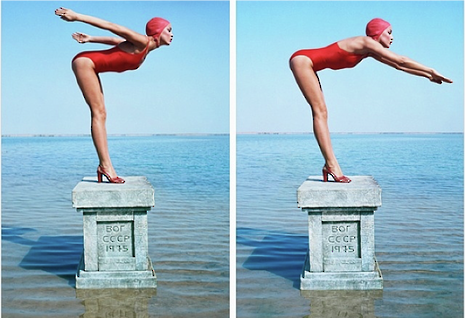Vogue at 100: a century of style
Kitty Grady reviews the exhibition at the National Portrait Gallery

Fashion is an industry that always moves forward. When Anna Wintour was asked what her favourite cover of American Vogue was during her time as editor, she coyly answered: “the next one”. As the world changes around us: socially, politically and economically, we look for new clothes to it our constantly changing sense of personhood. Therefore, creatively and commercially, fashion has no choice but to concern itself with what’s around the corner. It is a hugely lucrative and business-driven industry. Top designers create six collections a year, magazines work with a three-month lead time, and, with the rise of digital media meaning constant updates and untapped new markets, there just really isn’t time for fashion to sit back and reflect.
To put on the exhibition Vogue 100: A Century of Style at the National Portrait Gallery, therefore, seems to be at odds with the current state of the industry. Fashion is in a pivotal state of transition and disarray as the Kardashians and Kanye West takeover the runway, traditional formats for fashion shows are replaced by ‘see now buy now’ models, and creative director after creative director, from Raf Simons to Hedi Slimane, has announced their departure. As traditional print publishing goes through an existential crisis, with the staggering rise of free digital media like Twitter, Instagram and blogs, perhaps a look back through the old photo albums is a sobering way for a publication like Vogue to stabilise its sense of self from the dizzying new heights of the monster fashion has become.
On entering Vogue 100, however, you are surprisingly not confronted with the past, but the present. Behind a dazzling vertical collection of covers through the ages is a swanky video display with clips of every it-girl of the millennial generation from Cara Delevingne and Emma Watson to Alexa Chung and Edie Campbell. Set to sleek ambient house music, this is a firm nod to the magazine’s shift towards digital and multi-media platforms, and proof that even a retrospective in honour of their one hundredth birthday isn’t going to make them too nostalgic.
The angle the exhibition takes is that, since its creation in 1916, the magazine has been a “cultural barometer”, putting fashion in a wider social context and reflecting the changing lifestyles of women while showcasing the best of British culture. The Vogue franchise first reached the UK during the First World War, when shipping restrictions meant British women were unable to import the magazine from the USA, and indeed an early feature of the magazine were war reports from the trenches. After all, every reader, whether mother, wife, daughter or sister, would have had someone close to her on the front line.
From Cecil Beaton’s wittily poignant 1941 photograph ‘Fashion is indestructible’, to a fresh-faced Kate Moss photographed by Corinne Day, the exhibition proves that Vogue has been a consistent zeitgeist for contemporary culture. A cheery Prince Charles is photographed with his chickens, while a typically scruffy Boris Johnson sits perched atop a construction site in the Olympic park on the feature ‘Blond Ambition’. here is a strong focus on the icons of our age. Every significant figure of popular culture seems to have graced the pages of Vogue, from Posh and Becks and One Direction to David Bowie and Queen Elizabeth.
However, the fashion imagery Vogue creates transcends the pedestrian reality of current affairs. Photography is not just a practical and commercial means for us to view clothes but an art form of which it is the photographers who are the real stars. During the “disjointed times of sanitised entertainment and dystopia” of the 60s and 70s, Helmut Newton brought Britain his vision of extreme glamour with images like the sulphorous ‘Limelight Nights’.
We see Norman Parkinson and an Amazonian Jerry Hall voyage through the Soviet Union, Bruce Weber gives us a fresh take on Romanticism and Tim Walker offers us delicate but fantastical images that look like they’ve come straight from the pages of Lewis Carroll. Somewhat ironically, in a world where we are constantly bombarded by images, an exhibition is a simple but obvious way to force us to stop and really look at some of the most poignant photography of the last century.
Despite the frenetic pace of fashion, Vogue has stood strong as a cultural heavyweight whose prestige as a bastion of style and taste surpasses even the illustrious list of names that appear in its pages. So, happy birthday, Vogue, and here’s to many more.
Vogue 100: A Century of Style is on display until Sunday 22nd May at the National Portrait Gallery.
 Features / Should I stay or should I go? Cambridge students and alumni reflect on how their memories stay with them15 December 2025
Features / Should I stay or should I go? Cambridge students and alumni reflect on how their memories stay with them15 December 2025 News / Cambridge study finds students learn better with notes than AI13 December 2025
News / Cambridge study finds students learn better with notes than AI13 December 2025 News / Dons warn PM about Vet School closure16 December 2025
News / Dons warn PM about Vet School closure16 December 2025 News / News In Brief: Michaelmas marriages, monogamous mammals, and messaging manipulation15 December 2025
News / News In Brief: Michaelmas marriages, monogamous mammals, and messaging manipulation15 December 2025 Comment / The magic of an eight-week term15 December 2025
Comment / The magic of an eight-week term15 December 2025








